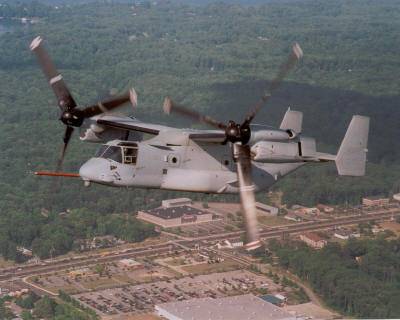Critics Say The Program Should Be Scrapped
 In a report released January 18,
2007, the Center for Defense Information (CDI), a Washington-based
think tank, says congress should scrap the V-22 program once and
for all. The report, titled "V-22 Osprey: Wonder Weapon or
Widow Maker?" was written by science and military journalist Lee
Gaillard.
In a report released January 18,
2007, the Center for Defense Information (CDI), a Washington-based
think tank, says congress should scrap the V-22 program once and
for all. The report, titled "V-22 Osprey: Wonder Weapon or
Widow Maker?" was written by science and military journalist Lee
Gaillard.
According to Gaillard, the Pentagon concluded in its September
2005 report the multi-role aircraft is operationally suitable and
compatible with flight and hangardeck operations. Yet, says
Gaillard, the Pentagon's report also shows the V-22 does not work
and faces operational, aerodynamic and survivability challenges
that will prove insurmountable -- and lethal -- in combat.
The Osprey has been plagued with problems since its first flight
in 1989. A truly marvelous system in concept -- twin, tiltable
rotors allow it fly both as a helicopter and an airplane --
Congress was on the verge of scrapping it in 2001 before allowing
development to continue. Engineers have only recently claimed to
have worked all the bugs out of the system, but not before 30
people died in four separate crashes.
According to CDI, "Three of those crashes were triggered by
below-standard parts, software and/or abysmal assembly line quality
control; the fourth was caused by a dangerous aerodynamic
phenomenon called 'vortex ring state' (VRS)."
VRS occurs when a helicopter descends into its own downwash. In
such a situation, the rotor's own downwash interferes with the
smooth laminar flow over its blades causing it to stall. CDI says
the V-22's extremely high-twist rotorprops make it particularly
vulnerable to VRS -- especially in situations requiring a rapid
descent such as a crew avoiding enemy fire in a hot landing zone.
VRS was blamed for the 2000 crash that claimed the lives of 19
marines and almost shut the program down.
According to the CDI's report, the design problem "has not been,
and probably cannot be, eliminated." Gaillard says the military is
aware of the issue and has limited maximum descent rates to 800
feet per minute for the V-22 -- an unreasonable restriction for the
aircraft given the environments and missions for which it's
intended.

The Osprey's manufacturing team from Boeing's and Textron's
helicopter divisions issued a scathing rebuttal to CDI's report. In
it the team says CDI is referring to problems that have already
been corrected.
Bell-Boeing spokesman Bob Leder told the Fort-Worth Star
Telegram, "It really baffles us as to why this organization would
come out with an anti-V-22 diatribe when clearly the aircraft is
performing well. Apparently, they just used a lot of out-of-date
information -- or disinformation."
James Darcy of the Navy's V-22 Joint Program Office says
military testing has shown the V-22 to be less susceptible to VRS
than traditional helicopters as it can speed through turbulent air
by tilting the rotors forward.
But, that doesn't answer how an aircraft speeding forward can
land vertically.
The V-22 Osprey is slated to see combat for the first time this
year in Iraq.
 ANN's Daily Aero-Linx (04.30.25)
ANN's Daily Aero-Linx (04.30.25) ANN FAQ: Turn On Post Notifications
ANN FAQ: Turn On Post Notifications Classic Aero-TV: Agile Aeros Jeff Greason--Disruptive Aerospace Innovations
Classic Aero-TV: Agile Aeros Jeff Greason--Disruptive Aerospace Innovations Aero-News: Quote of the Day (04.30.25)
Aero-News: Quote of the Day (04.30.25) ANN's Daily Aero-Term (04.30.25): Expedite
ANN's Daily Aero-Term (04.30.25): Expedite




